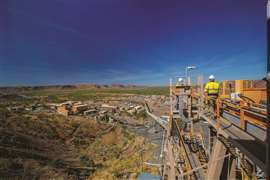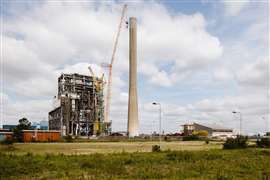Drilling smarter: Reducing your costs using the latest drilling technologies
11 February 2010

Drill rig manufacturers continue to make safer, quieter, more productive machines using the latest technologies as the demand for more cost effective equipment grows. Becca Durrant reports.
Improving operator comfort and safety remains a key product driver in the development of new drilling equipment. Manufacturers agree that reducing noise, simplifying cabin controls and enhancing the overall working environment can lead to increased productivity and perhaps more importantly today, lower operating costs.
Total costs
As contractors and operators alike become more knowledgeable about drilling processes the total cost of owning and operating drilling equipment is pushed further into the spotlight.
According to global product line manager for Sandvik's surface drills, Pekka Kesseli, lowering the total cost of ownership is of growing importance for manufacturers.
He said, "Customers are increasingly aware of total ownership costs. In the past it was just the initial purchase cost they were concerned with but now they understand that it is much more than that."
In order to address this issue he said the company aims to increase the productivity of its drilling equipment because ownership costs are measured in cost per tonne (or cost per hour) - while also reducing fuel consumption.
Mr Kesseli told iC the company's DPi series of drills, introduced in May 2008, feature lower operating costs and improved safety and productivity.
"We have made the machines simple and easy to use so there is more time for drilling," he said.
Andreas Malmberg, division president for Atlas Copco's surface drilling equipment said, "Total cost of ownership becomes more and more important as our customers are developing their understanding of the drilling and blasting cycle. It's not only the investment cost that is important for many customers but they now have a very good way of calculating all the operating costs - including fuel consumption, spare part consumption and operator costs - these factors are all becoming more of a day-to-day discussion compared to a few years back."
Meanwhile, Kevin Bates, Boart Longyear's director of capital equipment said the company has always been committed to reducing the cost of ownership for its customers, with the first step occurring long before they take delivery of the equipment.
He added, "Boart Longyear capital equipment and consumables go through extensive testing and performance evaluation prior to release. Data and feedback from field tests with our Drilling Services organisation is built into the design and development of new products, providing real insight before the product ever goes to market. We also manufacture rigs that better manage engine activity, for example idling the drill when not in use to reduce fuel consumption and minimise emissions."
Drilling control
Integrating electronic and automated drilling control systems has played a big part in increasing drill rig productivity by making processes safer, quicker and easier for the operator. This, is turn has also helped reduce operating costs for contractors.
According to Mr Kesseli on-board intelligence will feature heavily in future drill rig development and will only become more important as skilled operators become increasingly rare. In addition he said there is a growing trend within the industry to be able to obtain more information from the drill rig.
He added the DPi series rigs can provide real time data and performance information including the machine's maintenance status and location.
Meanwhile, Mr Malmberg said measuring and controlling the drilling cycle, including being able to export and import drilling data such as the position of holes as well as drill and blast planning, is becoming more evident in some larger operations.
He added Atlas Copco's Hole Navigation System (HNS) has provided the biggest impact in terms of improving drilling productivity because it can position holes and produce feedback.
Elsewhere, Mr Bates agrees that electronic systems play a key role in rig development.
"Real-time data acquisition on rig performance, control over all drill systems and self-diagnostic capability continue to drive the development of electronic systems, providing significant advantages to drillers. From monitoring rig performance for maximum depth capacity to step-by-step troubleshooting procedures and routine maintenance event tracking, electronics are adding critical functionality to today's class of drill rigs," he explained.
Safety first
According to Mr Bates the single biggest issue a drilling manufacturer faces is designing and developing products that not only protect the operator but enhance machine productivity.
He said, "For drilling contractors, this means removing the operator from the immediate work area." As another way of ensuring the operator's safety Boart Longyear has begun integrating its fully automated, hands-free rod management technology into all of its rig lines.
"This technology can make and break joints, and provide rod pick-up and transport without operator assistance. In addition, we have focused on introducing electronics, radio and cable control systems that further protect the operator," Mr Bates explained.
Atlas Copco also continues to focus on new ways of increasing operator safety and last year introduced the ROC D3-01 RRC and the ROC D3-03 RRC rock drill rigs featuring built-in radio remote control (RRC) systems.
Speaking for the company, Hakan Aytekin said, "The new ROC D3 RCC rigs not only enhance drilling performance and productivity, but also create a safer working environment in harsher, less stable terrain - which is where you most often rely on these rigs to perform."
The design of the RRC system in the new ROC D3 RRC models is based on the company's RRC systems found in the ROC T15 rig and the ROC D7 and D9 rigs.
Mr Malmberg told iC, "In some areas you could say that it's almost a legislative requirement that if you have a machine without a cab you cannot drill without radio remote control - this is the case in Sweden and it's spreading across Europe and I think we will go in that direction for the rest of the world as well."
He added the issue of noise inside and outside the cab is still of concern for manufacturers and despite already achieving significant reductions Atlas Copco continues to view noise reduction as an ongoing quest.
"We will continue to make developments not only with dampening devices at the source of the noise - but we will also look more into controlling different sound sources, e.g. the engine, the compressor as well as the cooling vents and dust collector," he explained.
Future focus
Undoubtedly drilling equipment manufacturers will continue to rely heavily on electronic and automated systems to improve productivity and reduce operating costs.
Mr Malmberg said the demand for improved jobsite communication and the on-going need to reduce operating costs will steer the future direction of drill rig development. Elsewhere, Mr Kesseli said improving energy efficiency via electronics and automation will be a key focus within the drilling industry, while Mr Bates said productivity and safety will remain the two biggest drivers.
"In addition to smart technology, driller training and product orientation play a key role in keeping contractors safe and the rigs running at optimal performance levels," he added.
STAY CONNECTED


Receive the information you need when you need it through our world-leading magazines, newsletters and daily briefings.
CONNECT WITH THE TEAM










